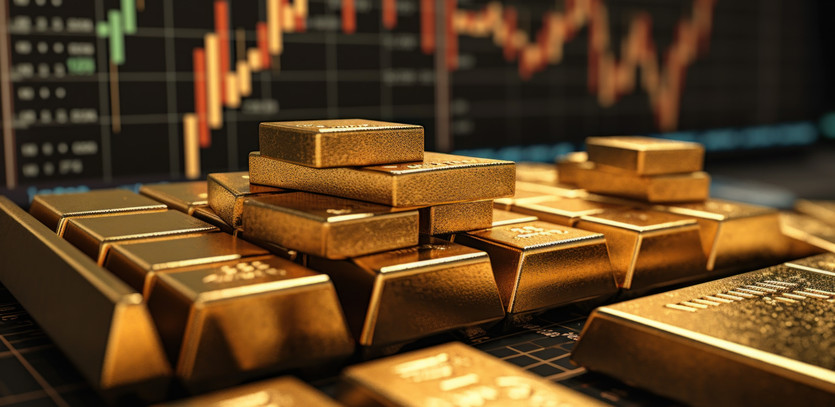Since the dawn of civilization, precious metals like gold and silver have acted as a reliable store of value, a means of exchange, and a symbol of affluence. Here are the main reasons why these metals allure investors:
- Historical reliability as a store of value
- Low correlation with often unpredictable financial markets
- Protection against inflation
However, like any investment, gold and silver come with their share of challenges, including liquidity issues and no yield generation.
In an era of escalating inflation and financial unpredictability, it's hardly surprising that these timeless investments are regaining their sparkle. Let’s explore the ideal ways to invest in these metals and answer some frequently asked questions to aid your investment journey.
Exploring Gold and Silver ETFs and Mutual Funds
Opting for gold and silver through financial instruments does alleviate some risks—storage and insurance. However, it's a step away from having a tangible investment. Today's market offers a plethora of gold and silver funds accessible through traditional brokerage accounts.
Different funds offer varying levels of exposure:
- Some funds replicate the ownership of gold or silver, holding only bullion of those specific metals.
- Others encompass the sector more broadly, holding other precious metals in varying proportions.
Though they may not track exactly with the price of physical gold, they provide:
- Diversification of physical gold or silver without carrying costs
- More liquidity to easily manage your gold and silver holdings
Prospecting Wealth with Gold and Silver Mining Stocks
Investing in gold and silver mining stocks offers a unique method of gaining exposure to these precious metals without the need for storing physical assets. Mining companies earn profits based on the difference between their mining costs and the market price of the metal. Consequently, they provide a leveraged bet on the price of gold and silver, rising significantly when the price of the metal increases.
Not all mining companies are created equal, however. Some focus on exploration, seeking new deposits and bearing the associated risks. Others focus on production, the steady extraction of minerals from known deposits. Each type carries different risks and rewards, and investors must understand these before investing.
Additionally, some mutual funds and ETFs specialize in gold and silver mining companies. These funds provide diversification among different companies, geographies, and stages of production or exploration, lowering risk compared to investing in individual mining companies.
Investing Directly in Physical Gold and Silver
Buying gold and silver bullion—bars or coins—is the most direct way to invest in these metals. The value of your investment will track the spot price of the metal closely. However, purchasing physical gold and silver requires considering storage and insurance costs.
There are various ways to invest in physical gold and silver, including buying bullion or coins from a dealer, purchasing from a mint, or acquiring a certificate from a gold or silver pool. The latter represents ownership of a specific amount of metal in a larger pool stored by the issuing institution.
In this way, direct ownership can be a tangible, direct hedge against economic uncertainty, currency fluctuations, or inflation. However, as with any investment, it's crucial to thoroughly research and consider the risks involved.
The Art of Investing in Gold and Silver Coins
Gold and silver coins, or bullion coins, bridge the gap between an investment asset and a collectible. Unlike the more functional bullion bars, these coins carry an aesthetic value that can make them more expensive than their melt value. The appeal, rarity, or demand for a particular coin boosts its numismatic value.
Gold coins are available in ounces and fractions of ounces (half ounce, quarter ounce, one-tenth ounce, etc.). These coins are priced above their melt value on their initial sale from the mint. Over time, the value of the coin can deviate from the melt price if it becomes a sought-after collectible. However, the melt price generally acts as the minimum value for a gold or silver bullion coin, fluctuating with the spot price of the respective metal.
Renowned gold bullion coins include the American Gold Eagles, Canadian Maple Leafs, and South African Krugerrands. These coins are produced by their countries’ respective mints, the sole manufacturers of legal tender. The U.S. Mint provides a product schedule for new releases that collectors can look out for.
Gold and silver coins are typically traded for more than their melt value, making them more of a collectible than an investment. You can acquire these coins through the same dealers that trade in bars or directly from the mints. Although these purchases include markups and fees, coins are smaller in size, making shipping fees lower than bars. These coins share many characteristics with bullion bars in terms of diversification and low correlation with financial markets, along with similar requirements for secure storage and insurance.
Jeweled Investments: Gold and Silver Jewelry
Gold and silver jewelry represent the furthest deviation from traditional investments within the category of physical silver and gold investing. The markup for jewelry can be significantly higher than the actual market value of the metals within the piece. Jewelry has more parallels with art than with bullion bars, and an authenticated piece with a notable previous owner can trade at its market value.
Precious metal-containing jewelry is more widely traded than bullion, which can make finding reputable dealers in the secondhand market more challenging. Ensuring the authenticity and confirmed purity of jewelry is crucial to its pricing. However, the aesthetics or history of a piece can drastically alter its market value. While jewelry still provides some degree of inflation hedging and a store of value, these benefits are somewhat diminished due to the nature of this form of investment.
Due to jewelry's subjective value, the necessity for secure storage and insurance, the higher risk of fraud, and the lack of recurring yield, jewelry is more of a collectible than an investment.
Setting Up Your Brokerage Account for Precious Metal Investments
The type of brokerage account you need depends on your intended precious metals investment. If you're investing in gold and silver funds and mining stocks, a simple brokerage account will suffice. If you plan to trade futures and options, make sure your chosen brokerage offers these options.
Personal Information
To open a brokerage account, you'll need to provide:
- Your name, address, and telephone number
- Tax identification number (usually your Social Security number)
- Date of birth and government ID
Most brokerages now operate online, so you'll likely need an email address to create an account. Before investing, you'll need to answer some personal questions to establish your income level, investment experience, net worth, and so on. These questions are part of the Know Your Client rules.
Minimum Deposits
Many brokerage accounts no longer require a minimum deposit. If you're investing in gold and silver ETFs, you can start with a small amount as some brokers offer fractional shares of these ETFs.
Best Online Brokers
| Company | Account Minimum | Fees |
|---|---|---|
| Fidelity Investments | $0 | No commission for stock/ETF trades. Options are $0.50-$0.65 per contract, depending on trading volume. |
| Interactive Brokers | $0 | No commission for equities/ETFs available on IBKR’s TWS Light, or low costs scaled by volume for active traders that want access to advanced functionality such as order routing. |
| Charles Schwab | $0 | $0 for stock/ETF trades, $0.65 per contract for options. |
How to Open a Gold IRA
Setting up a Gold IRA is a bit more complex than a regular IRA because a custodian must hold the physical assets. You cannot store your IRA bullion at home, for example. To set up a Gold IRA, you need to establish a self-directed IRA, choose a custodian to manage the account, select an approved depository to hold the assets, and then select a broker/dealer to buy the gold through. Custodians specializing in Gold IRAs usually help clients find an approved depository and gold dealers.
The Commodities Futures Trading Commission (CFTC) warns that "precious metals dealers are often not licensed or registered to provide investment or trading advice to retail customers. They are typically salespeople paid commissions based on the products they sell. Unlike financial professionals who have a fiduciary responsibility to you, these dealers are not obliged to have your best interests in mind. As a result, their recommendations are often driven by commissions and profits."
Personal Information
To open a Gold IRA, you need to provide:
- Your name, address, and telephone number
- Tax identification number (usually your Social Security number)
- Date of birth and government ID
- Additional KYC questions
Minimum Deposits
Minimum deposits in a Gold IRA can be quite high due to the high value of gold. While some Gold IRAs do not advertise a minimum deposit, others start at $10,000, $25,000, or even $60,000.
Companies like Augusta Precious Metals educate the public about popular gold and silver dealer scams and design their products to help customers avoid these scams.
Augusta Precious Metals Offer: FREE GOLD when you open a Gold IRA. ZERO fees for up to 10 years (everyone qualifies).
Best Gold & Silver IRAs
| Company | BCA Rating | Available Metals | Minimum Investment |
|---|---|---|---|
| Augusta Precious Metals | AAA | Gold, Silver | $50,000 |
| Goldco Precious Metals | AAA | Gold, Silver | $25,000 |
| Patriot Gold Group | AA | Gold, Palladium, Platinum, Silver | $25,000 |
Factors to Consider When Opening an Investment Account
The main factor to consider when opening an investment account is whether you can access the assets you want. Once this is confirmed, choosing an account becomes an exercise in comparing fees and capabilities. If you're interested in investing in silver and gold through financial derivatives, many brokers can accommodate this with minimal costs. If you're considering a Gold IRA, the fees can be significant, and you also need to account for the markups and fees that the dealer will charge. It's worth examining the disclosures and fee schedules of potential candidates.
How Do I Invest in Gold and Silver for Retirement?
Investing in gold within a retirement account can provide a hedge against inflation and exposure to an asset that has traditionally acted as a safe haven during times of financial market turmoil. You can easily gain exposure to gold in a traditional IRA by purchasing shares in gold ETFs, as most IRAs through brokerages allow you to invest in ETFs. For those looking to own physical gold in a tax-advantaged account, setting up a self-directed IRA with a custodian and approved depository is required. The right company for a Gold IRA can simplify things considerably.
What’s the Best Way to Invest in Gold?
There is no single best way to invest in gold. If you want to own physical gold, bullion bars are the most cost-efficient method, as their value is based less on aesthetics and more on purity and weight, reducing the markup. If you want exposure to gold as a financial hedge in a portfolio, an ETF offers liquidity and easy purchasing. If you want to trade based on gold price fluctuations, options on gold futures require the least capital and offer leverage. The only "bad" ways to invest in gold are bullion coins and jewelry, as their aesthetic appeal makes them more collectible than investment.
Should I Invest In Gold?
Gold can diversify your assets from market assets, but that doesn't mean it's for everyone. Those who use gold as a financial hedge seek to offset some of the risks associated with having their primary wealth tied up in financial markets. If you don't hold any stocks, bonds, or ETF investments, you might see a better return from buying those before considering gold. Similarly, someone who holds all their wealth in gold misses out on regular yields and may underperform compared to the market over long periods. Investing in gold through an ETF is a low-risk and relatively inexpensive way to gain exposure if you're interested. Even physical gold is fine if you want, but remember that knowledge and competence in investment are vital.





